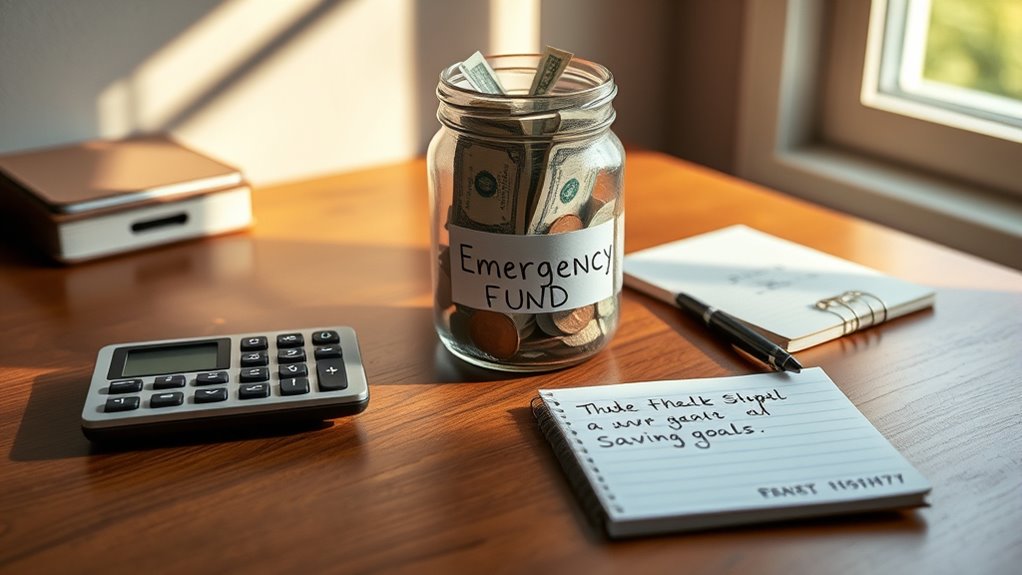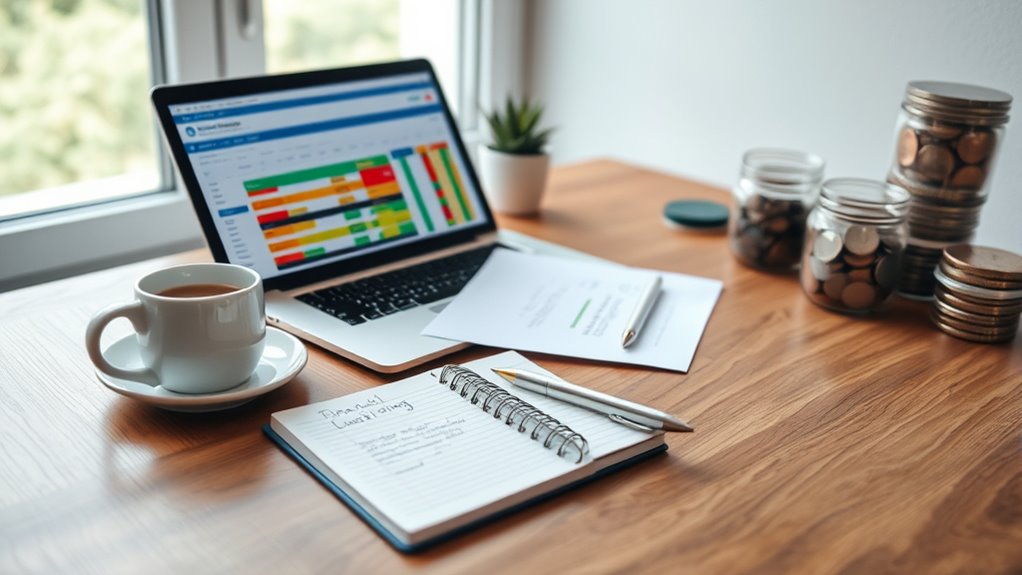To start your emergency fund, first track your expenses for a month to see where money goes. Then, set a realistic savings goal covering three to six months of living costs. Automate small, regular deposits to a separate account and cut unnecessary spending. Celebrate milestones to stay motivated and adjust your plan as your finances change. Keep building steadily, and you’ll soon create a safety net that boosts your financial resilience—learn more to keep moving forward.
Key Takeaways
- Track your income and expenses to identify savings opportunities and set clear financial goals.
- Allocate a fixed amount monthly and automate transfers to steadily grow your emergency fund.
- Prioritize reducing discretionary spending and find additional income sources to boost savings.
- Adjust your savings plan as circumstances change and celebrate milestones to stay motivated.
- Keep your emergency fund in a separate, accessible account to ensure quick access during emergencies.

Building an emergency fund might seem intimidating, but taking small, deliberate steps can make the process manageable. The key is understanding budgeting basics and applying effective saving strategies. Start by evaluating your income and expenses. Track your spending for a month to get a clear picture of where your money goes. This awareness helps you identify areas where you can cut back, making it easier to set aside funds specifically for your emergency stash. Creating a simple budget that prioritizes savings is your first step toward financial resilience. Allocate a fixed amount each month, even if it’s small; consistency matters more than size at first. Automate transfers to your savings account, so you don’t have to think about it. Automation reduces the temptation to spend what you’ve earmarked for your emergency fund and keeps your savings goal on track.
Next, focus on saving strategies that accelerate your progress. Consider setting a specific target—most financial experts recommend saving enough to cover three to six months of living expenses. Break this down into manageable chunks, like saving a little each week or each paycheck. If your income fluctuates, aim for a consistent percentage of your earnings rather than a fixed amount. Look for opportunities to boost your savings, such as reducing discretionary spending or finding additional income streams. Small sacrifices, like skipping dining out or cancelling unused subscriptions, can add up faster than you think. Remember, it’s not about depriving yourself but about making intentional choices that support your goal.
As you build your emergency fund, stay flexible and patient. Life can be unpredictable, so adjust your savings plan as your circumstances change. If you receive a raise or bonus, consider increasing your savings rate. Celebrate milestones along the way—each dollar saved brings you closer to your goal and boosts your confidence. Keep your emergency fund in a separate, easily accessible account to avoid temptation and ensure quick access when needed. Additionally, understanding the importance of home safety and reducing potential costs can fortify your financial resilience. Over time, your savings will grow, providing you with a safety net that reduces stress and increases your financial resilience. By sticking to your budgeting basics and implementing smart saving strategies, you’ll find that building an emergency fund is not only achievable but also empowering. Remember, every small step adds up, and with persistence, you’ll be prepared for whatever surprises come your way.
Frequently Asked Questions
How Much Money Should I Aim to Save for My Emergency Fund?
You should aim to save at least three to six months’ worth of living expenses for your emergency fund. This savings goal provides a buffer during unexpected events like job loss or medical emergencies. Incorporate this into your financial planning by setting realistic milestones and consistently contributing. Building this fund takes time, but it’s essential for financial resilience and peace of mind when life throws surprises your way.
What Are the Best Accounts to Keep My Emergency Savings?
You should keep your emergency savings in high-yield savings accounts or money market accounts, as they offer easy access and better interest rates. Avoid investing in stocks or bonds for emergency funds because those aren’t liquid. Look for account types with no fees and FDIC insurance, ensuring your money stays safe and accessible when you need it most. These accounts provide the best balance of safety and liquidity for your emergency fund.
How Do I Prioritize Saving for an Emergency Fund Versus Other Financial Goals?
Think of your financial priorities as a balancing act on a tightrope. To prioritize saving for an emergency fund, you should first stabilize your base with essential savings, then allocate funds toward other goals like retirement or debt payoff. Use smart savings strategies, like automating contributions, to guarantee your emergency fund grows steadily without sacrificing progress on your other financial goals. This way, your financial resilience stays strong and balanced.
What if I Face Unexpected Expenses While Building My Emergency Fund?
If you face unexpected expenses while building your emergency fund, don’t panic. Prioritize covering those expenses first to maintain your financial stability. To keep your emergency fund flexible, try to set aside a small amount each month, even if it’s less than planned. This way, you can handle surprises without derailing your savings progress. Remember, building resilience means adapting as needed while staying committed to your goals.
How Long Does It Typically Take to Build an Adequate Emergency Fund?
It usually takes several months to a year to build an adequate emergency fund, depending on your income and expenses. You’ll want to focus on smart investment strategies and debt management to speed up the process. Keep in mind, Rome wasn’t built in a day, so stay consistent and patient. Regular contributions, even small ones, help you reach your goal faster and create a sturdy safety net for unexpected events.
Conclusion
Building an emergency fund is a vital step toward financial resilience. Did you know that 40% of Americans can’t cover a $400 emergency? Don’t wait until you’re caught off guard—start saving today, even if it’s just a little each month. Every small contribution brings you closer to peace of mind. Remember, taking these simple steps now can protect you from future financial stress. Your stronger, more secure future begins with your first savings.









